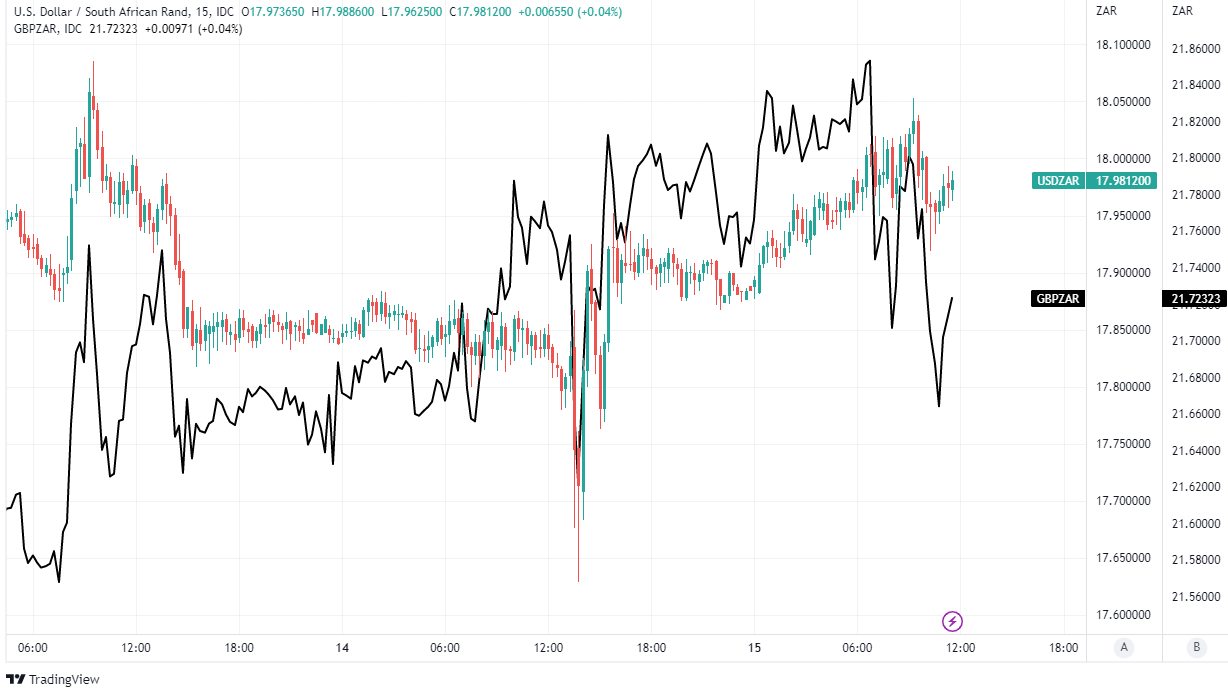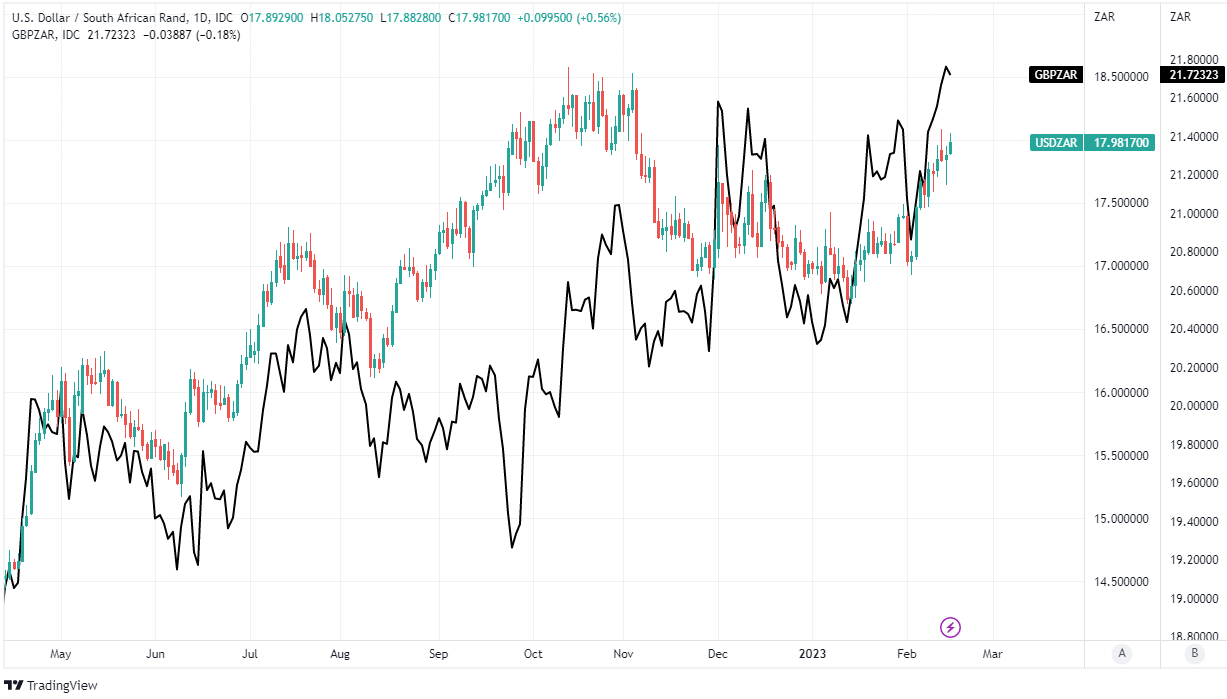South African Rand Struggles after Data Calls Time on SARB Rate Cycle
- Written by: James Skinner
"On this basis and barring further shocks, we think that the SARB’s hiking cycle is likely complete with the 25bp rate hike delivered in January" - Goldman Sachs.

Image © Adobe Images
The South African Rand rose against an underperforming Pound in mid-week trade but lagged behind others after retail sales figures surprised on the low side of expectations and inflation numbers led some analysts to suggest an end of the South African Reserve Bank (SARB) interest rate cycle is near.
Wednesday's Statistics South Africa data shows retail sales were -0.6% lower in December when consensus had looked for a 1% increase, suggesting a soft end to the year for an economy that has since been hampered by unprecedented power cuts and severe flooding.
Falling sales of pharmaceutical items combined with lower demand for hardware, paint and glass to drive year-end retail sales lower barely an hour after softer price growth in the services industry led some analysts to suggest the SARB's January increase in interest rates may have been the last.
"We maintain our forecast for a sharp decline in inflation in the coming months, with headline likely to fall below 6%yoy by March and to around the 4.5% mid-point by June," says Bojosi Morule, a CEEMEA economist at Goldman Sachs.
"On this basis and barring further shocks, we think that the SARB’s hiking cycle is likely complete with the 25bp rate hike delivered in January," she adds.
 Above: USD/ZAR shown at 15-minute intervals alongside GBP/ZAR. Click image for closer inspection. (If you are looking to protect or boost your international payment budget you could consider securing today's rate for use in the future, or set an order for your ideal rate when it is achieved, more information can be found here.)
Above: USD/ZAR shown at 15-minute intervals alongside GBP/ZAR. Click image for closer inspection. (If you are looking to protect or boost your international payment budget you could consider securing today's rate for use in the future, or set an order for your ideal rate when it is achieved, more information can be found here.)
South African inflation fell from 7.2% to 6.9% in January after a steep decline in petrol prices offset the impact of rising prices for other imported goods and just as a softer increase in services prices helped to keep the core inflation rate unchanged at 4.9%.
Core inflation removes internationally traded items like food, petrol and energy from the basket of goods for which prices are analysed in order to better gauge price trends originating from within the domestic economy, and so is often viewed by central banks as a more reliable inflation gauge.
Economists had looked on average to see South Africa's core inflation rate edging higher to 5% in January so the softer-than-expected outcome is something of a vindication for the South African Reserve Bank's January decision to lift its cash rate by only another 0.25%.
Financial markets and many economists had assigned a high probability to the idea of another 0.5% increase in the SARB cash rate for last month.
"SA’s Reserve Bank (SARB) revised down its GDP growth forecast for this year, from 1.1% y/y, to 0.3% y/y, after Eskom’s announcement on 22nd January that load shedding is likely permanent for this year," says Annabel Bishop, chief economist at Investec.
"The SARB also substantially weakened its forecast of SA’s economic growth rate for the next two years," Bishop adds.
 Above: South African Reserve Bank's January economic forecasts. To optimise the timing of international payments you could consider setting a free FX rate alert here.
Above: South African Reserve Bank's January economic forecasts. To optimise the timing of international payments you could consider setting a free FX rate alert here.
Wednesday's inflation data leaves the South African economy on course to undershoot the SARB forecast for a 5.1% core inflation rate over the first quarter and comes at a point when widespread flooding is adding to the economic disruption caused by unprecedented power cuts through January.
A weakening outlook for economic growth and inflation undermines market expectations for further increases in interest rates and amounts to a recipe for a more 'dovish' central bank policy stance that would likely limit the Rand's ability to rise against other currencies.
The Rand was a relative underperformer among G20 currencies in Wednesday trade but it still rose against Pound Sterling after a fall in the UK's January inflation rates exceeded those seen in South Africa as well as the declines anticipated by economists.
"One of the important drivers of the downshift in the size of rate hikes was the deteriorating outlook for growth due to the structural problem of electricity supply in the country," writes Burak Baskurt, chief EM strategist at BNP Paribas, in a Wednesday forecast review.
"We expect the rand to remain an underperformer within the high-beta, commodity-driven FX complex due to domestic factors undermining South Africa’s economic activity and external balances. Therefore, despite the overall USD weakness in our forecast profile, we forecast a flat USDZAR," he adds.
 Above: USD/ZAR shown at daily intervals alongside GBP/ZAR. Click image for closer inspection. (If you are looking to protect or boost your international payment budget you could consider securing today's rate for use in the future, or set an order for your ideal rate when it is achieved, more information can be found here.)
Above: USD/ZAR shown at daily intervals alongside GBP/ZAR. Click image for closer inspection. (If you are looking to protect or boost your international payment budget you could consider securing today's rate for use in the future, or set an order for your ideal rate when it is achieved, more information can be found here.)




